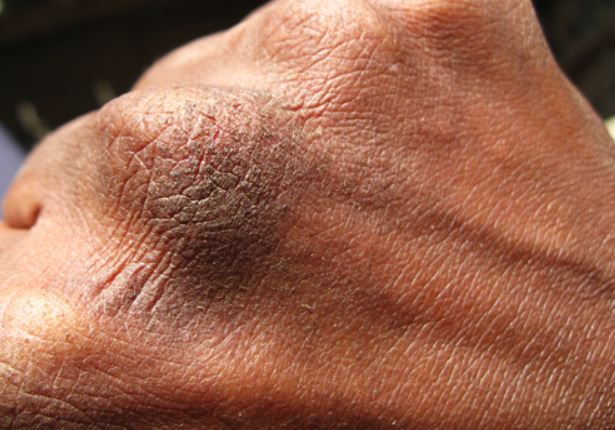With the ever-changing weather, our skin is bound to get affected at one point or another. It is the largest body organ responsible for regulating the body’s temperature as well as protecting it against infections hence requires optimum care.
Typically, dry skin is unable to hold/retain moisture which causes it to lose its efficiency when it comes to its functionality. Dry skin on knuckles feels and looks red, rough, itchy, tight and in severe cases might even crack and start bleeding.
However, with a proper care routine, you will be able to restore cracked knuckle to its original healthy state.

Signs and symptoms
Table of content
Just like any other part of the body, the knuckles are also susceptible to dry and possibly cracked. The occurrence of dryness is a gradual process that takes time to fully manifest and become noticeable.
1. Dry skin
it is characterized by its tight feeling which may be rough. These initial signs are not associated with any serious problem. However, ignoring these early signs creates a way for a more severe condition.
2. Very dry
This is characterized by extremely tight, rough, scaly and even itchy skin. Sometimes it may even appear scaly or flaky.
3. Severely dry skin
This is characterized by severely rough, scaly and flaky skin which may be extremely itchy and in more severe cases may crack and bleed.
Cracked knuckle is a result of a severely dry case. In this case, skin shrunk and became brittle thus cracks: especially because of the constant flexing of the joint in this area. The cracks are most common at the knuckles since the skin in this area is tight and easily breakable if stretched.
Causes
- Snow and cold weather conditions cause the air to become dry and harsh to our skin, this results in it being dehydrated or drying.
- Frequent hand exposure to washing alkaline and chemical detergents causes it to become dry.
- Constantly washing your hands using hot water for long periods of time especially, during baths interferes with the natural lipid layer of the skin causing it to become dry.
- Using an unsuitable skin care routine: your hands just like any other area of your body requires proper care. Hence it is important to know exactly which products are suitable for it, especially if it is dry. Using harsh soaps also strip away its natural moisture from your hands leading to dry, cracked knuckles.
- Certain medications (diuretics for controlling blood pressure) and treatments (radiation, dialysis, and chemotherapy) are in some cases responsible for dry skin which can lead to cracking.
- Age and hormonal changes: the skin’s moisture is sometimes influenced by the hormonal changes particularly during or after menopause and/or pregnancy. Additionally, with age, the body’s production of sebum decreases while at the same time, the ability to hold moisture also diminishes which leads to its drying and cracking.
- The frequent flexing or bending-straightening at the knuckles together with the dryness causes it to become highly susceptible to cracking.
- Some chronic medical conditions such as fungal infections, Eczema and Psoriasis can cause cracks and fissures to occur at the knuckles.
Treatment for cracked knuckle skin
Besides cracking of knuckle skin, bleeding can occur in extremely severe cases. However much this problem it, isn’t a life-threatening condition, it is important to treat the problem during the early stages to prevent exacerbation of the situation.
Hand creams: best natural hand creams to treat cracked knuckles
The number one cause of dry, cracked knuckles is the lack of proper moisturization. Therefore, moisturization is vital to enhance or jumpstart the healing process.
- Vitamin E oils are good moisturizers with natural anti-oxidants capable of hastening the healing process and reduce scarring.
- Coconut oil is a perfect remedy for treating cracked and bleeding knuckles
- Olive oil contains natural anti-aging agents which soften and makes your skin supple.
- Freshly squeezed Aloe Vera gel is good for moisturizing your skin. Additionally, it reduces inflammation and protects it from any further damage.
- Shea butter is rich in vitamin A, E, F and K which are capable of softening and promoting dry skin regeneration. However, because of its thick nature, it’s advisable to mix it with vitamin E oils for easier application.
Tips to prevent cracked knuckles
- During the cold, winter seasons wear woolen or leather hand gloves to prevent dryness and cracking at the knuckles. Additionally, cultivate the habit of wearing latex gloves to protect your hands from harsh chemical ingredients in washing detergents as well as water while working.
- Always apply some moisturizing creams and lotions on your hands after washing to prevent your hands from becoming dry. Additionally, if you feel your skin is tight, you can apply lotion several times during the day so as to maintain moisture.
- Apply some petroleum jelly every night after you finish your daily chores and wrap your hands with aluminum foil or a plastic bag for 10 minutes, remove the bag and rub the remaining jelly on your hands to soften and prevent dry skin.
- Ensure you drink plenty of water to keep your body hydrated.
However, if the condition persists kindly seek medical advice for proper diagnosis and treatment.
Sources
- http://www.byrdie.com/daily-skincare-routine
- https://www.webmd.com/skin-problems-and-treatments/eczema/understanding-eczema-symptoms
- https://www.mayoclinic.org/diseases-conditions/psoriasis/symptoms-causes/syc-20355840
- http://www.organicauthority.com/5-best-hand-creams-for-dry-cracked-knuckles-and-chapped-hands/
